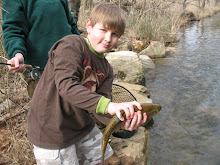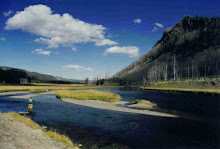 Just recently when tying a custom order of flies for my longtime friend and customer Larry Pritchett of High Point this very question came up. Larry and I go way back, both as friends and as a customer of mine when I worked in my first official flyfishing job in the late 1980's. And when Larry called me and we started to talk about the fly he wanted, I was very familiar with the pattern but then asked......what size is that fly you are wanting?
Just recently when tying a custom order of flies for my longtime friend and customer Larry Pritchett of High Point this very question came up. Larry and I go way back, both as friends and as a customer of mine when I worked in my first official flyfishing job in the late 1980's. And when Larry called me and we started to talk about the fly he wanted, I was very familiar with the pattern but then asked......what size is that fly you are wanting?Such questions always come up, in fact that is the #1 question that should come up. When Larry said, "I'll email you a picture of it", what I got was the picture to the left and I thought to my self.....that's brilliant. Just as I measure mayflies when trying to match a particular hatch, this fly was pictured next to a ruler in mm. Al Caucci and Bob Nastasi in their excellent books "Hatches" and "Hatches II" also measured the bugs they captured onstream the same way. Measuring bugs you are trying to imitate is a foolproof yes foolproof way of making sure your fly is as close to being the correct size it can be.
How can that be? For one, hooks differ slightly in shank length depending upon which manufacturer's hooks you are using. ORVIS and Daichii (my personal favorite) are standard length hooks, while two popular hooks - - the Tiemco 100 (wide gap hook) has a slightly longer hook shank and the Mustad 94840 has a slightly shorter hook shank. Thus, measuring the body size of an insect and then tying it in millimeters is one way to have the correct size no matter which hook you are using. This can be critical in cases where you fish regular hatches on local tailwaters like Virginia's Smith River and East Tennessee's South Holston and Watauga Rivers.
A small metal, wood, or plastic ruler with a mm scale on it is all you need. In fact, if you are trying to match a hatch or a particular insect or food item you don't even have to carry a ruler with you. Simply carry a paper index card and a waterproof Sharpie type marker, lay the insect on the card, and mark the exact length of the body. Under it write the type of fly you suspect it to be, time of day, and where you found it (riffle, run, pool, bushes, etc.) Such information can be very valuable both now and in the future.
So , is size that important? You bet. Normally, in our fly fishing classes we stress the importance of size, shape, then color and in that order. By far my experience has been that size is the most important factor in any case. In fact, even if you are on the water and don't have a fly that looks just right in terms of appearance, but can match the size of it to what's hatching, you at least have credibility to the fish in one respect. And that, as my time onstream has shown me, can sometimes mean the difference between at least a fish or two rather than nothing. And that always beats getting a "platinum bagel" ( '0')!




























No comments:
Post a Comment